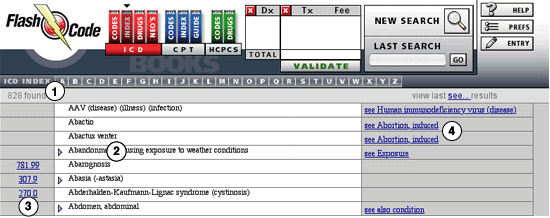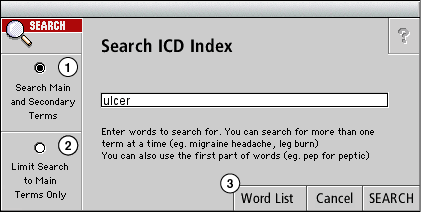
|
|
|
Next | ||
ICD Codes Alphabetical Index (ICD Volume Two) |
||||
|
|
||||

2. All primary terms that contain subterms are so indicated with a blue triangle. Subterms can be viewed by clicking on this triangle.
3. When an entry correlates to a specific ICD Codes record, the code number is displayed to its left. Click on this number to instantly view the full description of the code and to confirm it is a billable code.
4. There are over 11,000 'see' references to other potential codes within the ICD index. Just click on the link to jump to those codes. Flash Code allows a round trip to and from these links without losing your spot.
This is all very nice plus you can navigate through the alpha index quite quickly---but it is also very inefficient...The fastest way to get where you need to go within the alphabetical index is to perform a text search.

2. You can also find Main Terms only, like you would when paging through the alpha index of an official ICD-9-CM coding book.
As with all of the Flash Code searches, you can consult a word list that contains all of the words, in this case, all of the words found in the alphabetical index. Just type in the spelling of the word you want to find; the list will automatically adjust to the letters typed in.
Let's explore the two search options a bit more...
-Main Terms only: Let's assume you are interested in viewing all of the main terms that contain the word 'ulcer'. Click anywhere over the 'Limit Search to Main Terms Only' button. The search will return only Main terms that contain the word 'ulcer'. You can then click into any of those found records to see the entire listing of subterms, along with their organization, indentations, and corresponding ICD code numbers. (to see a main terms contents, click on the blue triangle to its immediate left)
-Main and Secondary terms: On the other hand, many of the main terms have very long listings associated with them ( For example, in the book the main term 'syndrome' has 22 columns of subterms...that's a lot of scrolling!).
If you already have a good idea of what you are looking for and don't want to spend any time scrolling, type in additional search terms and select the 'Search Main and Secondary Terms' option. A good example here would be to search for 'ulcer duodenal'. Here's a few more examples to try:
|
Search Type:
|
|
| Main Term Only | Main and Secondary Terms |
| Lesion | Lesion Lip |
| Burn | Burn Leg |
| Syndrome | Degos |